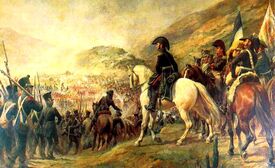
Spurred on by the revolutions in French Haiti and the emancipation of the 13 English colonies, a wave of support for independence began to form in Chile. Coupled with the French invasion of Spain by Napoleon Bonaparte, the South American people went from yearning for independence to fighting for it. Spanish loyalists still opposed their claim to independence, and the revolutionaries suffered a disparaging defeat at the Battle of Rancagua. After this loss, the future director of Chile, Bernardo O’Higgins, fled to Argentina. It was here that he would win the support of general Jose de San Martin, who planned to attack the loyalist positions in the south, beginning with Chile. In 1917 as Jose de San Martin marched a conglomerate army of Chilean and Argentinian soldiers over the Andes, the seeds were sown for Chilean independence. San Martin’s 6,000 men, 22 cannons, and 1,200 cavalry took the day at a hill near the valley of Chacabuco, over a loyalist force of 1,500 led by Brigadier General Rafael Maroto. San Martin had planned for this conflict since defecting from the Spanish military after the invasion of Napoleon. A Spaniard by blood but a Peruvian by birth, it is thought that San Martin took up arms against his former allegiances due to the inherent prejudice of the peninsular Spaniards against those born in the Indies. Here, the social hierarchies established in the Spanish colonies backfired, and witnessed a leader of considerable military talent force loyalists onto the defensive, ultimately causing the start of a continental revolutionary movement.
This depiction in the painting The Battle of Chacabuco was created by Italian- Chilean painter Pedro Subercaseaux. This painting was made during a time when the Chilean elite sought to promote a Chilean national identity with strong heritage and roots. Subercaseaux chose to paint the crossing of Jose de San Martin’s force over the Andes in 1817. Though there are many depictions of this crossing, commonality is the bright light towards which the army marches. Understood to represent the success that the army would later find, we unsurprisingly see a confident and professional San Martin candid with his soldiers, as they are both construed as sincerely devoted to their cause.
Works Cited
Bushnell, David. “José De San Martín.” Encyclopædia Britannica. Encyclopædia Britannica, inc., February 21, 2021. https://www.britannica.com/biography/Jose-de-San-Martin.
“Colonial Period.” Encyclopædia Britannica. Encyclopædia Britannica, inc. Accessed April 9, 2021. https://www.britannica.com/place/Chile/Colonial-period.
Image Link: https://en.wikipedia.org/wiki/Battle_of_Chacabuco#/media/File:Battle_of_Chacabuco.jpg
Thumbnail Link: https://es.wikipedia.org/wiki/Jos%C3%A9_de_San_Mart%C3%ADn#/media/Archivo:Jos%C3%A9_de_San_Mart%C3%ADn_(retrato,_c.1828).jpg
